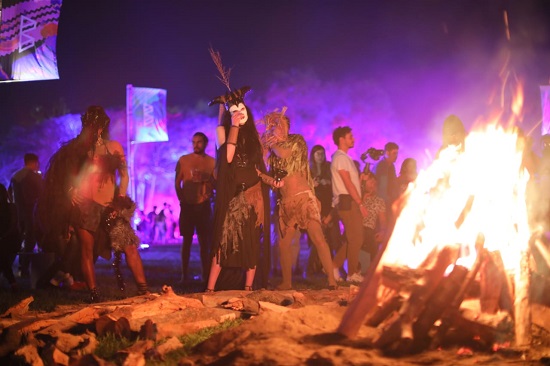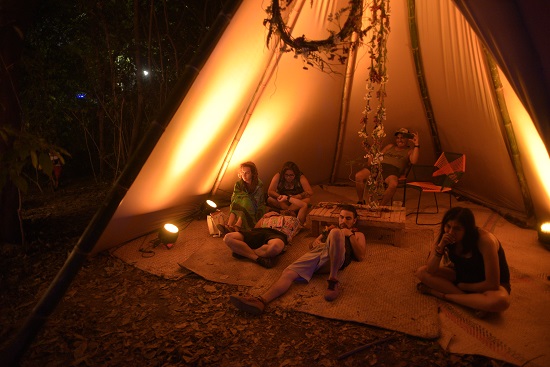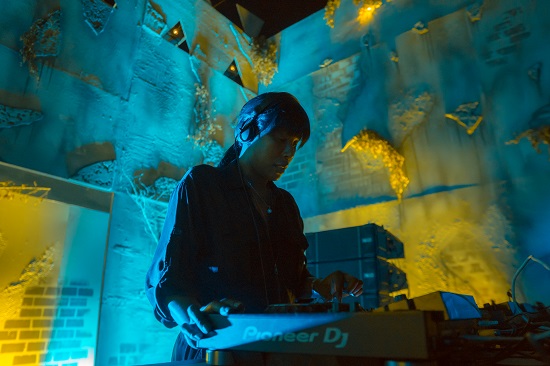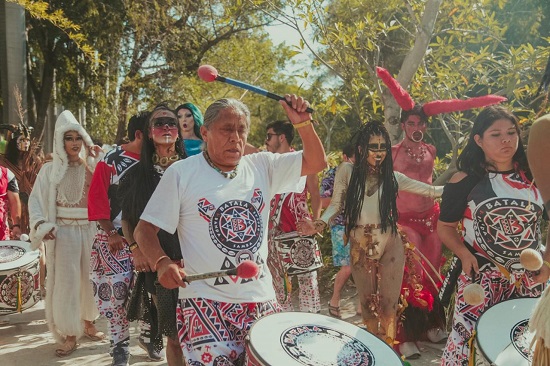Photo by Andrea Gunar
That the team behind Carnaval De Bahidorá got their hands on Las Estacas is something of a miracle. It is not just a beautiful site, in the way that Green Man or Festival No.6 are set in beautiful sites, it is a staggeringly pretty place. A part of the larger Sierra Montenegro state reserve, two and a half hours south of Mexico City by coach, it’s cut through by the Yautepec river. With a gentle current and pristinely clear, almost turqouise water, it’s a popular spot for freshwater scuba diving in the region’s dry months, and open for festivalgoers to cool off from the season’s beating sun with a swim – should the four swimming pools dotted elsewhere among the jungle not suffice.
Aside from one of the festival’s stages that’s nestled into a small clearing, one side of the river bank is dominated entirely by a dark green forest of colossal, looming trees. That’s free to explore too, within the site’s boundaries, but those borders can at times feel limitless as you delve deeper and deeper into the wilderness, winding forest pathways leading onwards and onwards past one gorgeous floral tableau after another. The river, crossed via rope bridge, runs across the entirety of the site, and downstream from the woodlands can be found the bulk of the festival itself. The entirety of Las Estacas is pocked with towering palm trees, offering shade over the pools, bars, restaurants and stages.

Photo by Feli Guttieres
Lucky Bahidorá. They have such wonderful grounds at their disposal that it would be very difficult for them to provide anything less than a lovely time. Yet this is a wonderful festival for reasons beyond the natural gifts Las Estacas. Given the amount of British festivals who phoned it in last summer with little more than an over-stuffed field and a £7 pint to their name, one might forgive Bahidorá for resting on their laurels a little. What’s so tremendous is that they do exactly the opposite.
Before the music begins at 11pm with an Underground Resistance takeover, we’re taken on a tour of the site. At first overwhelmed by the scale of the site’s beauty, there are added details at every turn. Look up at one particular cluster of palm trees and you’ll see a huge, anatomically correct human heart dangling among the leaves, daubed in light. Look closer at one of the brooks hidden deep in the forest and you’ll see a shimmering asymmetrical mirror reflecting kaleidoscopic light, like a portal to another kingdom. Deeper still into the woodland and you might stumble across the hoard of tiny white figures that make up Roberto López’s Regeneración placed amongst the trees, clambering tiny ladders and posed melodramatically in their own miniature world. It’s not just bunting that adorns one of the swimming pools, it’s art in its own right – the tremendous, cornucopic Flux by artist Lua Rivera. Under a knotted tree in a grassy clearing is a colossal, Sputnik-shaped hunk of metal, strobing in time with the music on the nearby main stage.
That stage, Sonorama, is itself stunning. It’s not that big, as outdoor stages go, but it’s beautiful, made up of three grand white and gold archways, with the branches of surrounding trees allowed to form part of the backdrop along with psychotropic visuals on a screen. In the harsh heat of the day, performers play under large white parasols as their audience reclines in the shade. After dark, light displays stream through foliage, casting a bewitching spell.

Photo by Oscar Villanueva
Another stage, home mainly to the weekend’s all-night dance programming, is equally beautiful, but in a bolder, more brutalist manner. The Bunker is a cragged, rough hunk of giant artificial steel and brick; only ugly Dorito’s branding spoils its austere, modish vibe. Then, there is El Umbral, an open field at Bahidorá’s northern border. Dotted with campfires and canopies, it’s here that the festival’s opening party is held on Friday night, with a marathon six-hour takeover from longstanding Detroit techno outliers Underground Resistance. The temperature drops sharply after dark; some warm themselves by the fire, others don ponchos and jumpers as John Collins begins his set. The Mark Flash Experience follows as the crowd are overcome by the carnival, the hectic flipside of the serene daylight hours. Sadly, jetlag kicks in before we can see DJ Dex and Esteban Adame welcome the sunrise with their set as El Coyote.
On Saturday morning the rivers and pools are fuller still. It is an idyllic place in which to awake. Those who decide to watch The Meridian Brothers in the harsh midday sun take a seat on the grass, under the shade of the trees that line the edges of the Sonorama arena. As the Bogotá group begin their set, however, one by one people stand up and shimmy their way into the sunshine for a dance. The band’s blend of folk, psychedelia, tropicalia, cumbia and dance is irresistible, flicking deftly from wonky, weaving melodies to moments of serenity and tenderness, as on the simply gorgeous ‘¿Dónde Estás María?’.

Blood Orange, photo by Feli Guttieres
Through the day, it is mostly music like this – though none better than the Colombians – that is hosted on the main stage. Cuban singer Daymé Arocena follows with up-tempo, soulful jazz, and then there is blissful, shimmering funk and Afrobeat from the Soul Jazz Orchestra. A laid-back set from Nightmares On Wax leads Sonorama through until sunset. It is a slight shame that this programming at times feels a little like a mere backdrop for the revelry that goes on elsewhere on the resort, but there is no ignoring Blood Orange. His set, after dark at Sonorama, is opulent, rich and fragile, it is multi-faceted, but most of all it is gorgeously powerful. There is no one who manages to inhabit this setting with quite as much charisma.
Blood Orange provides a linking point of sorts between the day and night at Bahidorá, which present two very different atmospheres. He guides us from the luxury of the daylight hours to the emotional charge that comes with sundown. None can encapsulate the sense of mania that takes over the festival’s energy after dark quite like Acid Arab, who provide a manic, searing set. After that, attention shifts to The Bunker, where Honey Dijon has already started racing through a blissful set of her own. The momentum keeps going, right until a headspinning show from Objekt until 8am.

Honey Dijon
The music at Bahidorá is programmed as one continuous block, 24 hours straight revelry in the perfect location for just that. It’s worth noting that criticisms have been made at the festival’s lack of inclusion of home-grown artists – the vast majority are from elsewhere in the Americas, and from Europe – but what becomes apparent at the party’s eventual close is that their programming otherwise betrays brilliance from the organisers. They have been gifted a preposterously beautiful place to have a festival, but what they do with it is what makes the event so special. There’s plenty of big brand partnerships, but at its heart Bahidorá feels like a festival crafted with the care and attention one finds only on the fringes on the European circuit; they instil a philosophy in the same way events like Sea Change, Supernormal or Milhões de Festa do, but they also maintain a mainstream appeal in a way that those festivals have never cared for. I have been to dozens of festivals with a ‘leave no trace’ message plastered performatively at every opportunity, but this is the only one where I’ve seen everyone in attendance follow that to the letter. Distrito Global, the organisation behind the festival, made their start within Mexico City’s DIY scene, and they clearly maintain that philosophy to this day. This is a wonderful, heavenly festival, and not just because of the site.


